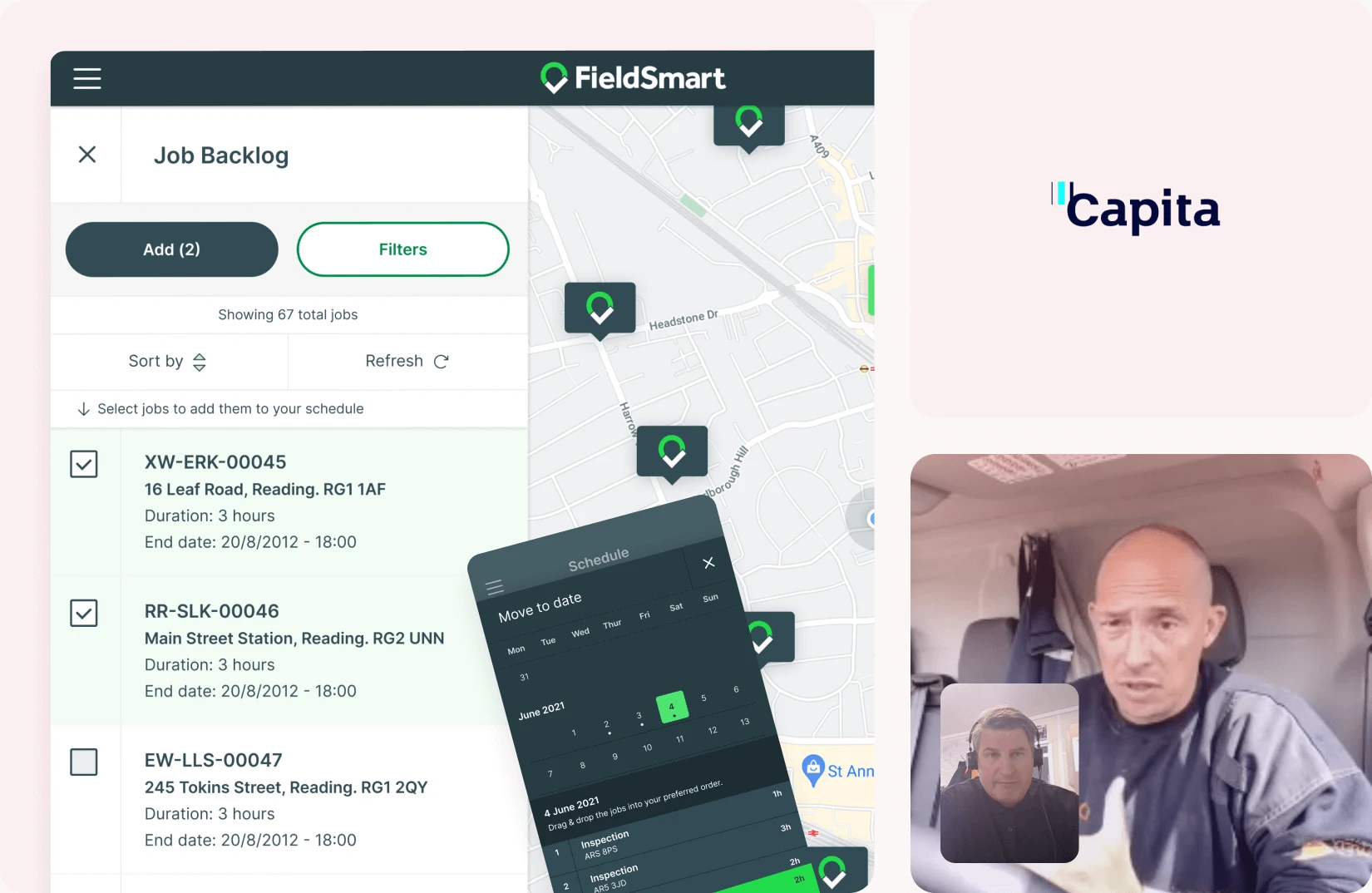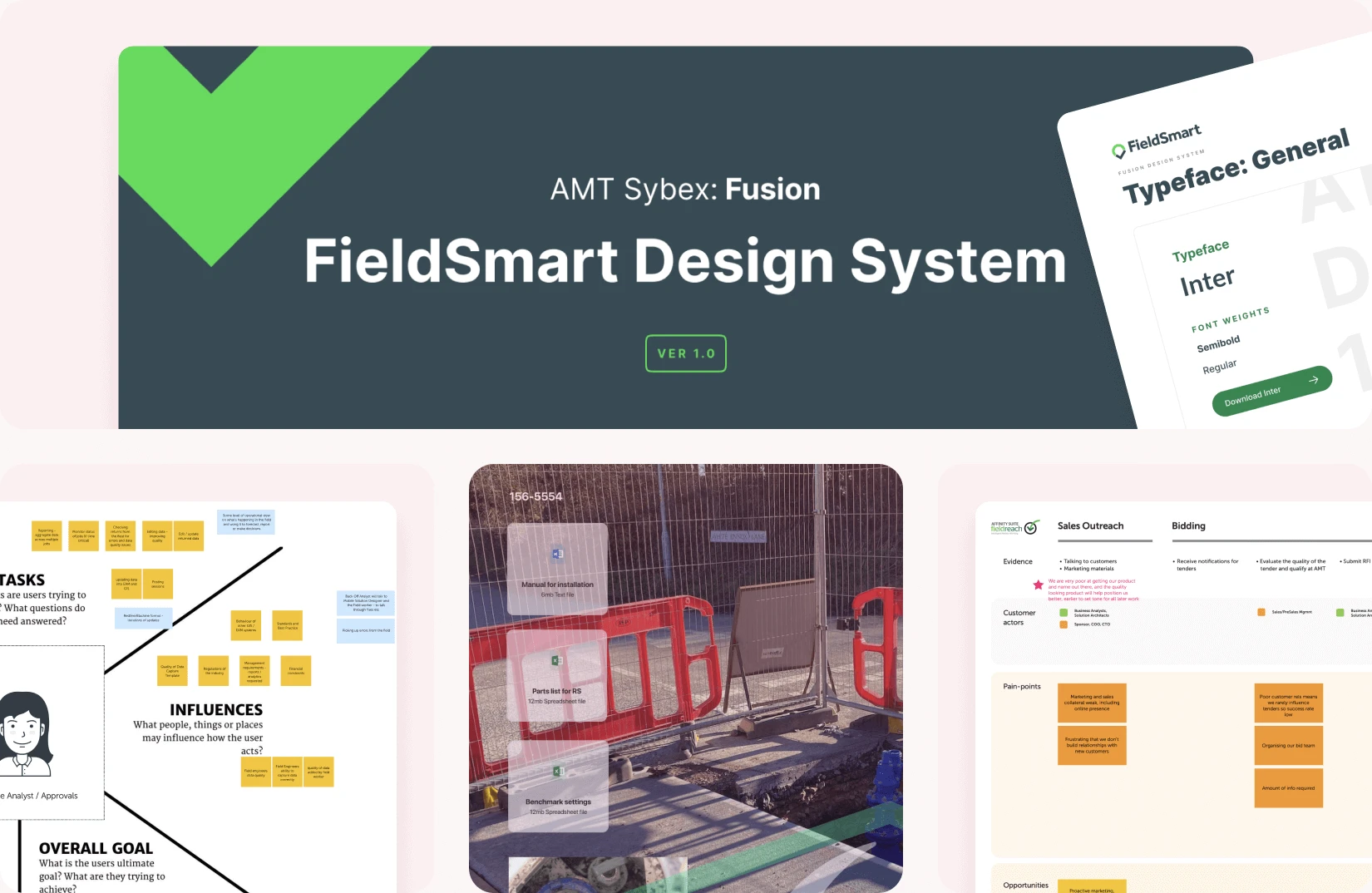Overview
Client: AMT Sybex (Capita)
Industry: Critical utilities and infrastructure software
Stage: Enterprise Legacy
Activity: Review of value proposition, Audit of solutions and technology requirements, Discovery, Vision, Product Design Sprints, User Research, Product Management, UI Direction, UI Design, UI Design System, Design and Research Enablement.
Challenge Overview
AMT Sybex had started a process of transformation, reviewing its technologies and development practices as it moved away from legacy tools and ways of working. In doing so, they wanted to address and understand at the same time how they could better involve customers and users in the redefinition of their software products.
Specifically, the organisation wanted to consolidate and streamline the capabilities of two legacy solutions one driven by geospatial mapping and the other supported workflow via forms and scripts. Both platforms served fieldwork management teams in the utilities industries, organisations with vast, dispersed teams across large territories. The utilities companies used the platforms to ensure that fieldworkers were supported in meeting productivity, health and safety measures. AMT Sybex wanted to understand how their customer organisations, such as Wessex Water, could enhance that productivity and efficiency through a more intuitive frontend architecture and UI that crucially would align more closely with the working context of their engineers.
Furthermore, the design and research functions within AMT Sybex were very small and in their infancy, so from the onset they were committed to ‘learning how to fish.’ Super User Studio delivered Enablement services to ensure that practices and methodologies were effectively handed over. As the organisation evolved, we supported key individuals in developing user research and UI design skills through workshops and coaching.
Overview
Client: AMT Sybex (Capita)
Industry: Critical utilities and infrastructure software
Stage: Enterprise Legacy
Activity: Review of value proposition, Audit of solutions and technology requirements, Discovery, Vision, Product Design Sprints, User Research, Product Management, UI Direction, UI Design, UI Design System, Design and Research Enablement.
Challenge Overview
AMT Sybex had started a process of transformation, reviewing its technologies and development practices as it moved away from legacy tools and ways of working. In doing so, they wanted to address and understand at the same time how they could better involve customers and users in the redefinition of their software products.
Specifically, the organisation wanted to consolidate and streamline the capabilities of two legacy solutions one driven by geospatial mapping and the other supported workflow via forms and scripts. Both platforms served fieldwork management teams in the utilities industries, organisations with vast, dispersed teams across large territories. The utilities companies used the platforms to ensure that fieldworkers were supported in meeting productivity, health and safety measures. AMT Sybex wanted to understand how their customer organisations, such as Wessex Water, could enhance that productivity and efficiency through a more intuitive frontend architecture and UI that crucially would align more closely with the working context of their engineers.
Furthermore, the design and research functions within AMT Sybex were very small and in their infancy, so from the onset they were committed to ‘learning how to fish.’ Super User Studio delivered Enablement services to ensure that practices and methodologies were effectively handed over. As the organisation evolved, we supported key individuals in developing user research and UI design skills through workshops and coaching.
Overview
Client: AMT Sybex (Capita)
Industry: Critical utilities and infrastructure software
Stage: Enterprise Legacy
Activity: Review of value proposition, Audit of solutions and technology requirements, Discovery, Vision, Product Design Sprints, User Research, Product Management, UI Direction, UI Design, UI Design System, Design and Research Enablement.
Challenge Overview
AMT Sybex had started a process of transformation, reviewing its technologies and development practices as it moved away from legacy tools and ways of working. In doing so, they wanted to address and understand at the same time how they could better involve customers and users in the redefinition of their software products.
Specifically, the organisation wanted to consolidate and streamline the capabilities of two legacy solutions one driven by geospatial mapping and the other supported workflow via forms and scripts. Both platforms served fieldwork management teams in the utilities industries, organisations with vast, dispersed teams across large territories. The utilities companies used the platforms to ensure that fieldworkers were supported in meeting productivity, health and safety measures. AMT Sybex wanted to understand how their customer organisations, such as Wessex Water, could enhance that productivity and efficiency through a more intuitive frontend architecture and UI that crucially would align more closely with the working context of their engineers.
Furthermore, the design and research functions within AMT Sybex were very small and in their infancy, so from the onset they were committed to ‘learning how to fish.’ Super User Studio delivered Enablement services to ensure that practices and methodologies were effectively handed over. As the organisation evolved, we supported key individuals in developing user research and UI design skills through workshops and coaching.
Our Engagement
Super User Studio delivered an end-to-end design service during the engagement, from discovery & vision processes, exploratory and validatory research, product design sprints, UI design, UX/UI design system and culminating in design enablement.
We kicked things off with a review and audit of the context, taking time to understand the business’ vision, the nature of the platforms, the customers and users being served and the scope for change. This process was undertaken cross functionally with both business and operational stakeholders, and the outcome included a set of strategic recommendations regarding the most efficient route to realising their vision.
The Vision process needed not only to align the organisation on how a new platform might take shape, but also give the organisation something tangible to work towards. Crucially though, our work needed to validate the proposition with target customers. To achieve this, we took business and project stakeholders through our Product Vision Accelerator, which resulted in the creation of a Vision Prototype that was then tested with key customers.
This Vision Prototype and our findings from the validation testing, helped us define a roadmap to an MVP. Also at this point, we led a series of UX Strategy sessions and workshops, plus further customer research to ensure the foundational principles of the new experience were defined before moving into product design. This involved designing conceptual journeys, prioritising features and workflows, as well as defining the global foundations for the new architecture, key UI regions and patterns.
We continued with the realisation of the MVP through a series of product design sprints. The 4-week long sprints included requirements studios, prototyping, UI design and user research where possible. This was all taking place during the pandemic, so gaining access to users in the field wasn’t achievable. However, as restrictions eased we are able to run interviews and testing in person in a COVIID secure manner.
Running parallel to this process was the design of a new look and feel and the creation of a modular UI design system. We worked closely with in-house designers to adopt the system, so they could continue to sustain the quality of the user experience after we left.
We continued to define and design key workflows in order to produce the MVP. As we did this, we designed workshops, coaching and feedback sessions with the in-house designers and support teams to support their growth and development. We helped the organisation identify what an optimum Product team might look like of their context and delivered a guide to the tools and processes we’d used throughout for their ongoing learning. Our aim was to support them in reaching self-sufficiency.
Results & ROI
Feedback from the client has been incredibly positive and crucially impactful both on the way they now work and reading the quality of the solutions they can now offer to their customers. Having only completed our engagement in 2022, it can typically take many months, if not years, to be able to quantify the impact of our work. In this case, the value was realised far more quickly when AMT Sybex were acquired by Jonas Computing for £40M just months after the launch of the MVP.
"Their experience, expertise, and knowledge are impressive, and what they’ve brought to the table in terms of knowledge is hard for anyone else to match. The product is above and beyond anything we’ve produced before. Moreover, our team has learned a lot from what they’ve done. We’re now doing things by ourselves, and when we share such processes with our customers, the feedback is incredibly positive."
Product Director, Capita

